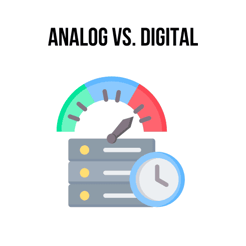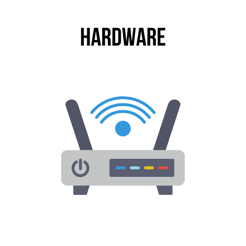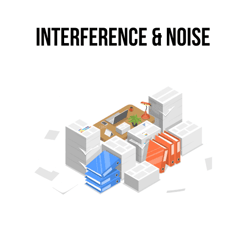
Bandwidth is the maximum amount of data that travels over a network connection in a given amount of time.
Perhaps the best way to understand this concept is by thinking of it as a highway’s width. The wider the highway, the more vehicles (or data) can travel on it simultaneously.
Every day, we interact with bandwidth in one way or another; we just don’t realize it. For instance, you’re reading this paragraph because bandwidth made it possible. It allowed this content to travel from the server to the page you’re reading.
Because of bandwidth, you can stream videos, download content quickly, and play responsive online games. And if you run a business with a digital presence, bandwidth helps support multiple users, cloud-based applications, video conferencing, and other data-intensive activities.
-
Navigate This Article:
Understanding Bandwidth
To further understand bandwidth, let’s look at it from three different environments: telecommunications, computing, and networking. For now, we’ll only focus on its importance in these environments; we’ll discuss how it works later.
Telecommunications
When you make a phone call, the communication travels through various frequencies to transmit signals. These frequencies are what we call bandwidth in telecommunications. Have you ever wondered why some phone calls may sound clearer than others?
It could be for many reasons, low bandwidth being one of them. Higher bandwidth provides a wider route for data to travel simultaneously, improving the quality and speed of voice and data communications over phone lines, mobile networks, and other telecommunication systems.
Computing
Things are different in computing. Here, bandwidth determines the rate at which data travels between computer components or over computer networks.
Take your computer’s memory or storage device as an example. Bandwidth affects how quickly data can be read from or written to those components. As a result, it determines overall system performance.
Networking
When we talk about bandwidth in networking, we’re referring to the maximum rate of data transfer across a given path. Here, bandwidth has the final say on how quickly data can travel between devices on a network.
And like computing, bandwidth in networking also influences the performance of internet connections, local area networks (LANs), and wide area networks (WANs).
Bandwidth vs. internet speed: It’s important to set the record straight regarding the difference between bandwidth and internet speed. Bandwidth is the capacity of a connection to handle data. Internet speed is the actual rate at which data travels at a given time.
How It Works
So far, we’ve defined bandwidth and explained its importance in different environments. Now, let’s address the elephant in the room: how bandwidth works.
Data Transmission
We all know that data transmission is the movement of data from one point to another. For this transmission to be successful, you must add two things to the equation: a network and bandwidth.

The network is the vessel in which the data travels. It could be a cable, wireless signal, or fiber optics, for example. As we’ve said earlier, bandwidth is the network’s capacity to handle said data.
So, when the bandwidth is high, you can transfer more data from one point to another. Remember when we used a highway as an example? The wider the highway, the more vehicles can pass at any given moment.
Analog vs. Digital Bandwidth
Analog bandwidth measures the range of frequencies that an analog signal can occupy.

In contrast, digital bandwidth measures the data rate in bits per second (bps) that can travel over a digital network. Besides the environments in which these two operate, the main difference is analog signals are continuous, while digital signals are discrete.
Analog signals are continuous waves that vary over time. They represent sound in a smooth, uninterrupted manner, like in a traditional radio.
Digital signals, on the other hand, are discrete packets of data. Each data packet represents binary code (1s and 0s). You can’t listen to a digital signal — you only get to interact with whatever it dishes out, like a video, webpage, etc.
You should know: We use hertz (Hz) to measure analog bandwidth. If you were born between the 1960s and early 1990s, you probably saw AM/FM radios labeled “KHz” near the tuning button. KHz is short for kilohertz, a measuring unit for the frequency of audio signals being transmitted to that particular device.
How to Measure Bandwidth
To measure bandwidth, you need to calculate the amount of data transmitted over a network within a specific time frame. This measurement is usually done in bits per second (bps).
You can use different software and tools to measure bandwidth. Some common examples of these tools include:
- NetFlow Analyzer
- Bwmonitor
- Nagios
- System Monitor
- Paessler PRTG
With these tools, you can determine the maximum data transfer rate over that particular network. You may then use this information to diagnose network performance issues or optimize and manage your network infrastructure for better performance.
Pro tip: You can calculate bandwidth for video conferencing using this online bandwidth calculator tool.
Types of Bandwidth
As discussed earlier, there are two types of bandwidth: digital and analog. But between these types of bandwidth, you’ll find other subcategories we haven’t discussed before. Let’s dive deeper into the details.
Types of Digital Bandwidth
As the name implies, this type of bandwidth only serves the digital space. Under digital bandwidth, you’ll find three subcategories: internet, network, and device bandwidth.
Here are some key takeaways from these three types of digital bandwidth:
- Measured in bits per second (bps), digital bandwidth is the data transfer capacity in digital systems like streaming and downloading. We use bits per second (bps) as the measuring unit for digital bandwidth.
- Network bandwidth is a subcategory of digital bandwidth and deals with local or wide area networks.
- Device bandwidth refers to the data transfer limits of individual devices, such as computers or smartphones. It determines how quickly they can send or receive data.
With that out of the way, now let’s look at analog bandwidth and its subcategories.
Types of Analog Bandwidth
We mentioned that analog bandwidth is measured in hertz (Hz) and represents the range of frequencies that an analog signal can occupy. The three main subcategories here are radio frequency, video, and audio bandwidth.
Here’s an overview of what they entail:
- Radio frequency bandwidth is the range of frequencies used for transmitting radio signals. This type of bandwidth affects the clarity and reach of broadcasts.
- Audio bandwidth, in contrast, focuses more on different sound frequencies that audio equipment can handle. As a result, it impacts the quality and fidelity of sound reproduction.
- Lastly, video bandwidth is all about the frequency range required to transmit video signals and is responsible for deciding the resolution and quality of video broadcasts or recordings.
By understanding both digital and analog bandwidth, users can better manage and optimize their data transmission needs, ensuring efficient and high-quality communication across different mediums.
Factors Affecting Bandwidth
Many different factors can affect how bandwidth works. So, having high bandwidth alone won’t get the wheels rolling as they should. For perspective, let’s look at these factors that could affect bandwidth.
Bandwidth Limitations
The service provider often imposes bandwidth limitations. For example, if you’ve ever purchased an internet bundle for your home or mobile device, you may have noticed that your plan has a bandwidth limit.

This is what many people confuse with network speed. We’ve already seen the difference between these two — bandwidth is the capacity to handle data transfer and network speed is how fast data travels.
Some providers may cap the maximum data transfer rate available to you. Nine times out of ten, they do this to ensure that everyone in the network gets a sufficient share of bandwidth.
This cap can restrict the speed and volume of transmitted data and affect the overall network performance.
Bandwidth Usage Patterns

Another reason providers restrict bandwidth is to avoid overuse. People have different usage patterns, and sometimes, one person’s usage habits could impact another person on the same network.
Regarding usage, high-demand activities such as video streaming, large downloads, and gaming can consume substantial bandwidth. As a result, such activities tend to slow down other users and applications on the same network.
Impact of Hardware and Infrastructure
Let’s go back to the example of a wide road. We’ve used this example to show you how bandwidth works in real life. The wider the road, the more vehicles can pass at any given time.

Now imagine having a road in poor condition with potholes, unmarked lanes, no road signs. In that case, the road’s ample width doesn’t make up for its poor condition.
The same logic applies to the quality and capability of hardware and infrastructure; they determine the quality of bandwidth performance.
Routers, switches, and cabling must support the required data rates. If they’re outdated or substandard, they can create bottlenecks, impacting the effective use of available bandwidth.
Interference and Noise

As ridiculous as it sounds, interference and noise from other electronic devices or environmental factors can disrupt data transmission and reduce bandwidth effectiveness.
For perspective, an internet router might not work properly if situated in places with physical obstacles.
The same applies when you place the router next to other wireless or electromagnetic devices. The router might work under these conditions, but it won’t be able to perform at its best.
Importance of Bandwidth
Bandwidth is one of the most important pieces in the puzzle of the modern digital communication system. It influences everything from internet speed to overall network performance. In this section, we’ll explain its importance in different environments.
Impact on Internet Speed
Higher bandwidth allows for faster internet speeds. As a result, it also reduces latency and improves the user experience for activities such as browsing, streaming, and gaming.
Role in Network Performance
In a network, bandwidth helps manage data traffic between devices. When a network has enough bandwidth, multiple devices can communicate and share resources without congestion. Sufficient bandwidth also means a smoother and more reliable network performance.
Significance in Multimedia Streaming
We’ve said that high bandwidth helps deliver high-quality audio and video content. So when you watch a video online and it keeps buffering, part of this problem could be that the network is struggling to travel through the allocated bandwidth.
In this context, buffering is the network’s way of complaining that it can’t get through the narrow lanes from the server to your device. To fix this problem, you’ll need to upgrade the bandwidth.
Implications for Cloud Computing
In cloud computing, bandwidth facilitates the transfer of large volumes of data between local devices and cloud servers. Sufficient bandwidth ensures efficient data synchronization, quick access to cloud-based applications, and smooth operation of cloud services.
In other words, cloud computing simply can’t work without bandwidth.
Common Misconceptions About Bandwidth
Bandwidth is one of the most important web hosting definitions you should know, yet it’s also one of the most misunderstood concepts in the modern age of technology.
People use bandwidth in different contexts, including places that don’t fit. For instance, the term bandwidth has been used to describe internet connectivity, which shouldn’t be the case. In this section, we’ll highlight some of the most common misconceptions about bandwidth.
- Myth: Bandwidth and internet speed are the same.
- Truth: While they are related, bandwidth refers to the capacity of a connection, whereas speed is the actual data transfer rate experienced.
- Myth: More bandwidth always means a faster connection.
- Truth: Factors like network congestion, hardware limitations, and the quality of service are what determine connection speed.
- Myth: Bandwidth can be easily borrowed from other users on a shared network.
- Truth: In reality, the available bandwidth is usually divided among all users. When one user consumes too much bandwidth, it slows down the experience for others.
- Myth: Upgrading to a higher bandwidth will resolve all network issues.
- Truth: If the hardware or service quality is inadequate, upgrading the bandwidth is just a drop in the ocean of things that must be done to fix this issue.
Understanding these misconceptions is important as they can help you decide when or how to conduct network upgrades or troubleshoot connectivity issues.
Bandwidth Management Strategies
The whole point of managing bandwidth is to make sure that network resources are used efficiently and critical applications receive the necessary bandwidth to function optimally. Here are some proven strategies to achieve this goal.
Prioritizing Network Traffic
On the topic of prioritizing network traffic, think of a busy highway as an example. Emergency vehicles like fire engines are prioritized when navigating traffic. That’s exactly how bandwidth management works at the network level.
Prioritize your network traffic in order of mission-critical applications and services that require more bandwidth. By so doing, essential tasks, such as business operations and communication, are not disrupted by less important activities.
Implementing Quality of Service (QoS)
Quality of service (QoS) works similarly to prioritizing network traffic. It refers to a set of techniques used to manage and control network traffic.
Here, you assign different priority levels to various types of data. When you do that, QoS ensures that high-priority services, such as video conferencing and VoIP, have sufficient bandwidth during peak usage.
Bandwidth Optimization Techniques
Sometimes, you can’t solve bandwidth-related issues by simply increasing bandwidth. Instead, you should apply optimization techniques to help maximize the efficiency of available bandwidth and improve overall network performance.
These techniques include:
- Reducing the size of data files to decrease the amount of bandwidth needed for transmission.
- Storing frequently accessed data locally to reduce the need for repeated data transfers over the network.
- Controlling the flow of data to ensure a consistent and manageable load on the network.
Once you’ve put these optimization techniques in place, you’ll be less worried about network traffic congestion.
Bandwidth Monitoring and Analysis Tools
Bandwidth monitoring and analysis tools can help you understand bandwidth usage. Some of these tools and techniques include:
- Monitoring and analyzing IP traffic data to understand usage patterns.
- Capturing and analyzing data packets traveling through the network to identify bottlenecks.
- Continuously tracking the performance of network components and traffic.
- Using Simple Network Management Protocol to gather and analyze network performance data.
With this information, you can identify areas for improvement and make the right decisions.
Future Trends
We live in a world with a growing demand for faster and more reliable connectivity. There are about 5.35 billion global internet users.
Remember, bandwidth determines how stable an internet connection is. That’s to say, without bandwidth, there’s no internet connectivity. Let’s look at other fields where the demand for bandwidth won’t run dry anytime soon.
Emerging Technologies
Every day, some form of new technology is invented. Most of these technologies have something to do with the internet and, therefore, bandwidth.
The following are some prime examples:
- 5G networks provide higher bandwidth and lower latency, which make mobile and wireless communications even faster.
- Fiber optic expansion increases the reach and capacity of high-speed internet services.
- Edge computing reduces the bandwidth load on central servers by processing data closer to the source.
- Satellite internet expands internet access to remote and underserved areas.
In each of the technologies mentioned above, bandwidth is at the heart of almost every operation.
Bandwidth Expansion Initiatives
Bandwidth expansion initiatives are all about upgrading existing infrastructure and deploying new technologies to increase data transfer capacities. The U.S. government, for example, pumps about $10 billion into states and territories to fund capital projects.

In 2023, Wisconsin received $33 million for digital connectivity and technology projects, where bandwidth plays an important role.
Private companies haven’t been left out, either; they are investing heavily in expanding fiber optic networks, rolling out 5G, and developing new standards for wireless communication to keep pace with growing data demands.
One report found that wireless providers in America invested $39 billion in 5G technology in 2022 — a new record.
Implications for Industry and Consumers
For industries, increased bandwidth supports the growth of technologies like IoT devices, smart cities, and advanced automation.
As these technologies continue to evolve and use the power of bandwidth, consumers will experience faster internet speeds, improved streaming quality, and enhanced connectivity for smart home devices.
Challenges and Opportunities
The growth and expansion of bandwidth undoubtedly bring many opportunities. But it also comes with challenges worth noting.
These challenges include but are not limited to high deployment costs, regulatory hurdles, and the need for cybersecurity enhancements.
On the flip side, these challenges also open up opportunities for innovation in network management, security solutions, and cost-effective infrastructure development.
Real-World Applications
Earlier in this article, we discussed that we interact with devices or platforms that use bandwidth daily. Now, let’s examine real-world examples where bandwidth is the leading actor.
- The telecommunications industry uses bandwidth to provide high-quality voice and data transmission.
- The IT sector relies on sufficient bandwidth for cloud computing, data centers, and seamless remote work.
- The entertainment and media industry uses high bandwidth for streaming services, online gaming, and digital content distribution.
- In healthcare, bandwidth supports telemedicine, electronic health records, and the Internet of Things (IoT), all of which allow real-time data transmission and improve patient care.
Based on these examples alone, can you estimate how many times per day you use a technology that relies on bandwidth?
Embracing the Evolution of Bandwidth
It’s impossible to overlook the impact of bandwidth on various aspects of our lives. It plays a role in nearly every technology we use.
That also explains why the outlook for bandwidth is promising. As long as we witness ongoing advancements in technologies like 5G, fiber optics, and edge computing, bandwidth will remain at the center of everyday technology.
So, how do we (consumers and technologists) become part of bandwidth’s evolution? It’s simple: staying ahead of the curve and investing in cutting-edge infrastructure is a proven way to fully harness bandwidth’s potential to create a more connected and efficient world.







